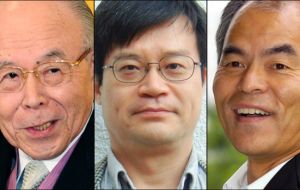MercoPress. South Atlantic News Agency
Inventors of new energy efficient LED light bulbs, awarded Nobel for Physics
 Isamu Akasaki and Hiroshi Amano of Japan and Japanese-born US citizen Shuji Nakamura developed the blue light-emitting diode (LED)
Isamu Akasaki and Hiroshi Amano of Japan and Japanese-born US citizen Shuji Nakamura developed the blue light-emitting diode (LED) An American of Japanese origin and two Japanese scientists won the 2014 Nobel Prize for Physics on Tuesday for inventing a new energy-efficient and environment-friendly light source, leading to the creation of modern LED light bulbs.
Isamu Akasaki and Hiroshi Amano of Japan and Japanese-born US citizen Shuji Nakamura won the prize for developing the blue light-emitting diode (LED) -- the missing piece that now allows manufacturers to produce white-light lamps.
The arrival of such lamps is changing the way homes and workplaces are lit, offering a longer-lasting and more efficient alternative to the incandescent bulbs pioneered by Joseph Swan and Thomas Edison at the end of the 19th century.
“Red and green LEDs have been around for a long time but blue was really missing. Thanks to the blue LED we now can get white light sources which have very high energy efficiency and very long lifetime,” Per Delsing, a member of the Royal Swedish Academy of Sciences, told a news conference.
The award is a notable example of a practical discovery winning the prize -- in contrast to last year, when the physics prize went to scientists who predicted the existence of the Higgs boson particle that explains how elementary matter attained the mass to form stars and planets.
“Incandescent light bulbs lit the 20th century; the 21st century will be lit by LED lamps,” the academy said in a statement.
Frances Saunders, president of Britain's Institute of Physics, said the shift offered the potential for huge energy savings.
“With 20 percent of the world’s electricity used for lighting, it’s been calculated that optimal use of LED lighting could reduce this to 4 percent. Akasaki, Amano and Nakamura’s research has made this possible and this prize recognizes this contribution,” she said.
Akasaki is at the Meijo University in Japan and Amano is professor at the Nagoya University. Nakamura is at the University of California, Santa Barbara.
Nakamura invented the blue-light emitting diode while working at Nichia, an unlisted firm, but received next to nothing from them for the work until 2004, when the Tokyo District Court ordered Nichia to pay him a record 20 billion yen.
The LED boom upended the lighting market, creating both opportunities and challenges for major players like Dutch group Philips, which has been making light bulbs for 123 years but is now splitting off its lighting business.
As winners of the physics award, the laureates join some of the biggest names in science such as Albert Einstein, Niels Bohr and the husband and wife team of Pierre and Marie Curie.

![“Working directly with President [Donald] Trump and Congress, we accomplished what no one else could,” Patel stressed](/data/cache/noticias/108417/130x80/fbi.jpg)


Top Comments
Disclaimer & comment rules-

Read all comments“The award is a notable example of a practical discovery winning the prize -- in contrast to last year, when the physics prize went to scientists who predicted the existence of the Higgs boson particle that explains how elementary matter attained the mass to form stars and planets.”
Oct 08th, 2014 - 11:06 am 0Ha, ha, ha.
Short sightedness right to the fore as usual.
The blue LED is without doubt an important energy saver.
The IMPLICATIONS of the Higgs boson particle is of IMMENSE importance to the future of the human race.
Very disappointing articel but well done to the three team leaders who were named. Remember, they didn't do it on their own.
Commenting for this story is now closed.
If you have a Facebook account, become a fan and comment on our Facebook Page!